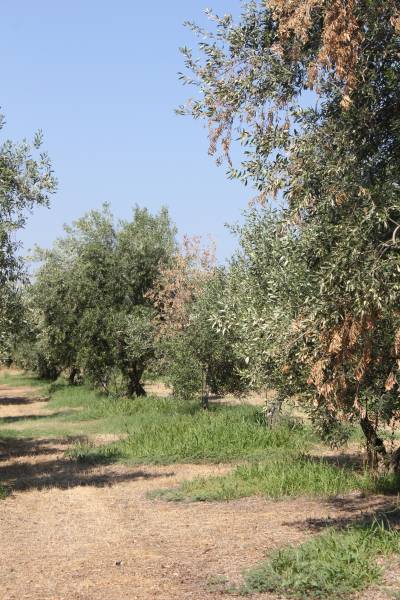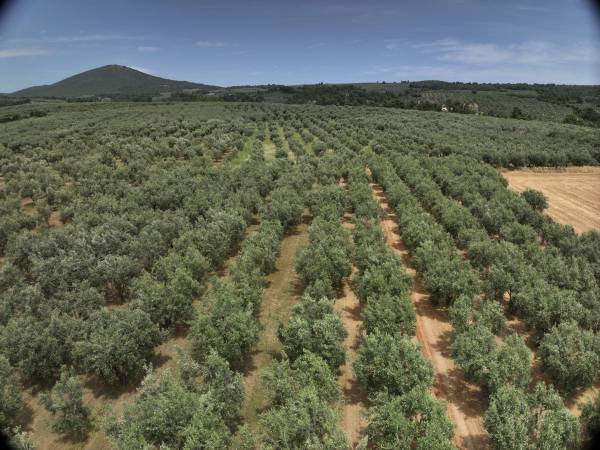Tackling Verticillium dahliae and Pseudomonas savastanoi pv. savastanoi
by Spyridoula Dimitropoulou | Research Associate | AUA
Olive groves are a key element of the Mediterranean landscape and heritage. In Greece, olive cultivation has a long-standing tradition, widespread across the country and still maintained in many rural regions. Olive production is vital to both the Greek economy and cultural identity, with Greece ranking among the top global producers of olives and olive oil. Yet, the industry faces growing challenges due to emerging pests and diseases that threaten both yield and quality. Among the most significant pathogens in Greek olive groves are Verticillium dahliae, the causal agent of Verticillium wilt, and Ο Pseudomonas savastanoi pv. savastanoi, which causes olive knot disease.
The challenge of olive tree diseases in Greece
In areas such as Attica and Atalanti, olive growing plays a vital role in local economies, with around 22,212 olive holdings spanning roughly 23,521 hectares in Attica alone, providing income and employment for thousands of people involved in olive cultivation and production [1]. The ongoing expansion and intensification of olive farming have brought substantial shifts in cultivation methods aimed at boosting productivity. However, the dominance of monoculture systems, coupled with the accelerating effects of climate change, has heightened the vulnerability of olive trees to both soil-borne and airborne pathogens across Europe [2]. In Greece, these uniform planting practices, together with the region’s typical Mediterranean climate – characterized by hot, dry summers and mild, wet winters – create highly favorable conditions for pathogen development and spread, increasing the impact of diseases such as Verticillium wilt and olive knot.
Verticillium dahliae and Verticillium Wilt
Verticillium dahliae is a soil-borne fungus that invades the olive vascular system, disrupting water and nutrient transport in olive trees, which leads to wilting, branch dieback and, in severe cases, tree death [3]. Its ability to survive for long periods of time in the soil and within plant debris forming resistant structures and the limited efficacy of chemical control measures, make this pathogen a problem for perennial tree crops like olive [4]. It spreads through contaminated soil, irrigation water, cultivation equipment, and infected plant material, and can attack a broad range of cultivated crops across Greece.
As there are no chemical treatments capable of curing infected trees, farmers primarily depend on preventive approaches such as:
- using V. dahliae-free planting material,
- cultivating resistant olive varieties,
- applying soil disinfestation techniques, and
- improving soil drainage and cultural practices.
Despite these efforts, Verticillium wilt continues to pose a serious threat to olive production, resulting in reduced yields and significant economic losses.

Ο Pseudomonas savastanoi pv. savastanoi and Olive Knot Disease
Olive knot disease is caused by the bacterial pathogen Ο Pseudomonas savastanoi pv. savastanoi that produces tumor-like galls or knots on stems, branches and, occasionally, on leaves and fruits. A single infected tree can lead to the rapid infection of an entire orchard, with colonisation occurring in as little as one year. The pathogen spreads quickly through rain, wind, insects, and contaminated pruning tools, and the bacteria remain inside tree tissues, making complete eradication nearly impossible.
To manage disease, farmers depend on preventive strategies such as:
- using copper-based treatments to slow disease progression,
- disinfection of pruning tools, and
- use of disease-free planting material.
Nowadays olive knot disease is present worldwide wherever olive trees are grown. Although losses are difficult to assess, it is assumed that olive knot is one of the most important diseases of the olive crop [5]. Olive knot disease weakens trees, reduces fruit production, and increases susceptibility to secondary diseases, posing a serious challenge for Greek olive growers.
Detection and Monitoring of Olive Tree Pathogens
Detection and monitoring of olive tree pathogens traditionally rely on field surveys, visual inspections, pathogen isolation, and microscopy. In the case of Verticillium wilt, soil testing can give insights into infection levels, while olive knot disease is often spotted by the characteristic galls that appear on branches. In the lab, confirmation usually involves bacterial cultures, biochemical tests, and modern molecular diagnostics like PCR.
While these conventional approaches have long formed the backbone of olive tree disease detection, they are not without limitations. Visual inspections can be unreliable because symptoms vary depending on environmental conditions and the tree’s phenological stage. Culture-based methods are time-consuming and demand significant technical expertise. Soil composition, climate, and other environmental factors can further complicate accurate diagnosis. Of particular concern are latent Verticillium infections, which can progress unnoticed until substantial damage has occurred.
The challenges of traditional detection highlight the urgent need for innovative monitoring technologies – solutions that offer faster, more accurate, and proactive protection for Greece’s treasured olive trees.
Toward Sustainable Disease Management
Recent innovations are helping to address these challenges, including the use of IoT sensors for real-time environmental monitoring, remote and proximal sensing to detect early disease symptoms, and predictive models to forecast potential outbreaks. These technologies enable farmers to:
- identify problems early,
- apply targeted interventions,
- reduce pesticide use,
- limit crop losses, and
- enhance overall productivity.
An effective strategy for controlling V. dahliae and P. savastanoi relies on combining traditional and modern diagnostic methods with structured monitoring programs. Strong collaboration among researchers, farmers, and policymakers improves disease surveillance, while public awareness and community engagement support early detection and help lower management costs.
By integrating scientific research, advanced technologies, and coordinated action, Greece can safeguard its olive trees and ensure the long-term sustainability of its olive sector, preserving a vital part of both its economy and culture. Initiatives like the STELLA Horizon EU Project are playing a key role by collecting data from regions such as Attica and Atalanti, supporting advanced disease monitoring, and promoting sustainable management practices for olive growers across the country.
 Figure 2: Olive trees in Atalanti Region, Greece
Figure 2: Olive trees in Atalanti Region, Greece
Credits: Agricultural University of Athens (AUA)
References
[1] Hellenic Statistical Authority. (2018). Olive trees: Number of holdings, area and number of trees, by region, Crop surveys, 2017.
[2] Landa, B. B. (2019). EIP-AGRI Focus Group, Pests and diseases of the olive tree. Funded by European Commission, 1-20.
[3] Jimenez-Diaz, R. M., Cirulli, M., Bubici, G., del Mar Jimenez-Gasco, M., Antoniou, P. P., & Tjamos, E. C. (2012). Verticillium wilt, a major threat to olive production: current status and future prospects for its management. Plant disease, 96(3), 304-329.
[4] Basile, B., Sigillo, L., Mataffo, A., & Corrado, G. (2023). Vegetative response to Verticillium dahliae of italian varieties of olive (Olea europaea L.). Horticulture, Environment, and Biotechnology, 64(6), 943-953.
[5] Ramos, C., Matas, I. M., Bardaji, L., Aragón, I. M., & Murillo, J. (2012). P seudomonas savastanoi pv. savastanoi: some like it knot. Molecular plant pathology, 13(9), 998-1009.



